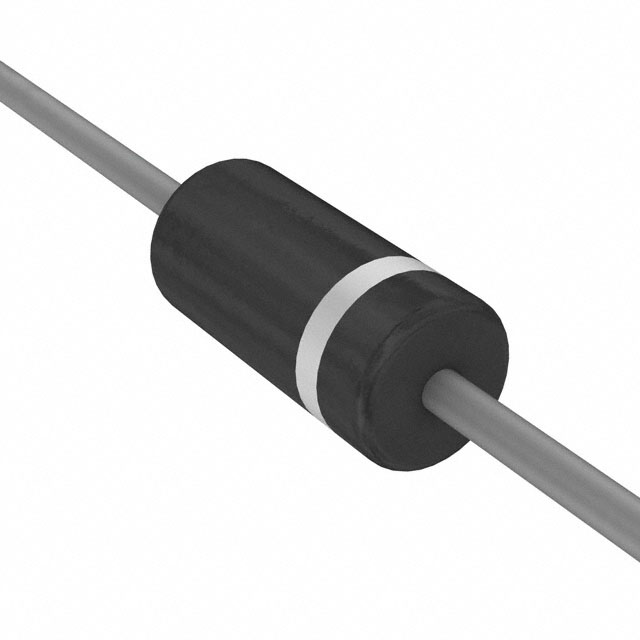SAC30-E3/54
Product Overview
Category
The SAC30-E3/54 belongs to the category of semiconductor devices.
Use
It is used as a rectifier diode for general purposes in electronic circuits.
Characteristics
- Forward current: 3A
- Reverse voltage: 40V
- Package type: DO-214AB (SMC)
- Fast switching speed
- High surge current capability
Package
The SAC30-E3/54 is typically available in tape and reel packaging.
Essence
This rectifier diode is essential for converting alternating current (AC) to direct current (DC) in various electronic applications.
Packaging/Quantity
It is commonly packaged in reels containing a specific quantity, such as 1000 units per reel.
Specifications
- Maximum Average Forward Current: 3A
- Peak Forward Surge Current: 150A
- Maximum DC Blocking Voltage: 40V
- Operating Junction Temperature Range: -65°C to +175°C
- Storage Temperature Range: -65°C to +175°C
Detailed Pin Configuration
The SAC30-E3/54 has two pins: 1. Anode (A) 2. Cathode (K)
Functional Features
- Efficient rectification of AC to DC
- Fast switching speed for improved performance in electronic circuits
- High surge current capability for reliable operation in demanding conditions
Advantages and Disadvantages
Advantages
- Fast switching speed enhances circuit efficiency
- High surge current capability ensures reliability in challenging environments
- Compact DO-214AB package for space-saving designs
Disadvantages
- Limited maximum DC blocking voltage of 40V may not be suitable for high-voltage applications
Working Principles
The SAC30-E3/54 operates based on the principle of rectification, allowing the flow of current in one direction while blocking it in the opposite direction. When forward-biased, it conducts current efficiently, enabling the conversion of AC to DC.
Detailed Application Field Plans
The SAC30-E3/54 is widely used in the following application fields: - Power supplies - LED lighting - Automotive electronics - Consumer electronics
Detailed and Complete Alternative Models
Some alternative models to the SAC30-E3/54 include: - 1N5820: Similar specifications with a higher DC blocking voltage - HER308: Higher current rating and reverse voltage capability - MBR3045PT: Schottky barrier rectifier with different characteristics
In conclusion, the SAC30-E3/54 rectifier diode offers efficient rectification, fast switching speed, and high surge current capability, making it suitable for various electronic applications. While it has limitations in terms of maximum DC blocking voltage, it remains a popular choice for designers seeking reliable rectification in low to medium voltage circuits.
[Word count: 414]
قم بإدراج 10 أسئلة وإجابات شائعة تتعلق بتطبيق SAC30-E3/54 في الحلول التقنية
Sure, here are 10 common questions and answers related to the application of SAC30-E3/54 in technical solutions:
Q: What is SAC30-E3/54? A: SAC30-E3/54 is a lead-free solder alloy composed of 99.3% tin, 0.7% copper, and a small amount of other elements.
Q: What are the key applications of SAC30-E3/54? A: SAC30-E3/54 is commonly used in electronics assembly, such as surface mount technology (SMT) and through-hole soldering.
Q: Is SAC30-E3/54 suitable for high-temperature applications? A: Yes, SAC30-E3/54 has good thermal stability and is suitable for high-temperature applications within its specified limits.
Q: Does SAC30-E3/54 comply with industry standards for lead-free soldering? A: Yes, SAC30-E3/54 complies with RoHS and other industry standards for lead-free soldering.
Q: What are the advantages of using SAC30-E3/54 over traditional lead-based solders? A: SAC30-E3/54 offers improved environmental friendliness, higher reliability, and better mechanical properties compared to lead-based solders.
Q: Can SAC30-E3/54 be used for rework and repair of electronic components? A: Yes, SAC30-E3/54 is suitable for rework and repair processes, provided proper techniques and equipment are used.
Q: What flux type is recommended for SAC30-E3/54 soldering? A: Rosin-based or no-clean fluxes are commonly recommended for SAC30-E3/54 soldering applications.
Q: Are there any specific precautions to consider when using SAC30-E3/54 in technical solutions? A: It's important to follow proper handling, storage, and disposal practices for SAC30-E3/54 to ensure safety and compliance with regulations.
Q: Can SAC30-E3/54 be used for soldering dissimilar metals? A: Yes, SAC30-E3/54 can be used for soldering dissimilar metals, but proper surface preparation and flux selection are crucial for achieving strong joints.
Q: What is the shelf life of SAC30-E3/54 solder wire or paste? A: The shelf life of SAC30-E3/54 solder wire or paste is typically specified by the manufacturer and should be followed to ensure optimal performance.
I hope these questions and answers are helpful for your technical solutions involving SAC30-E3/54. Let me know if you need further assistance!


